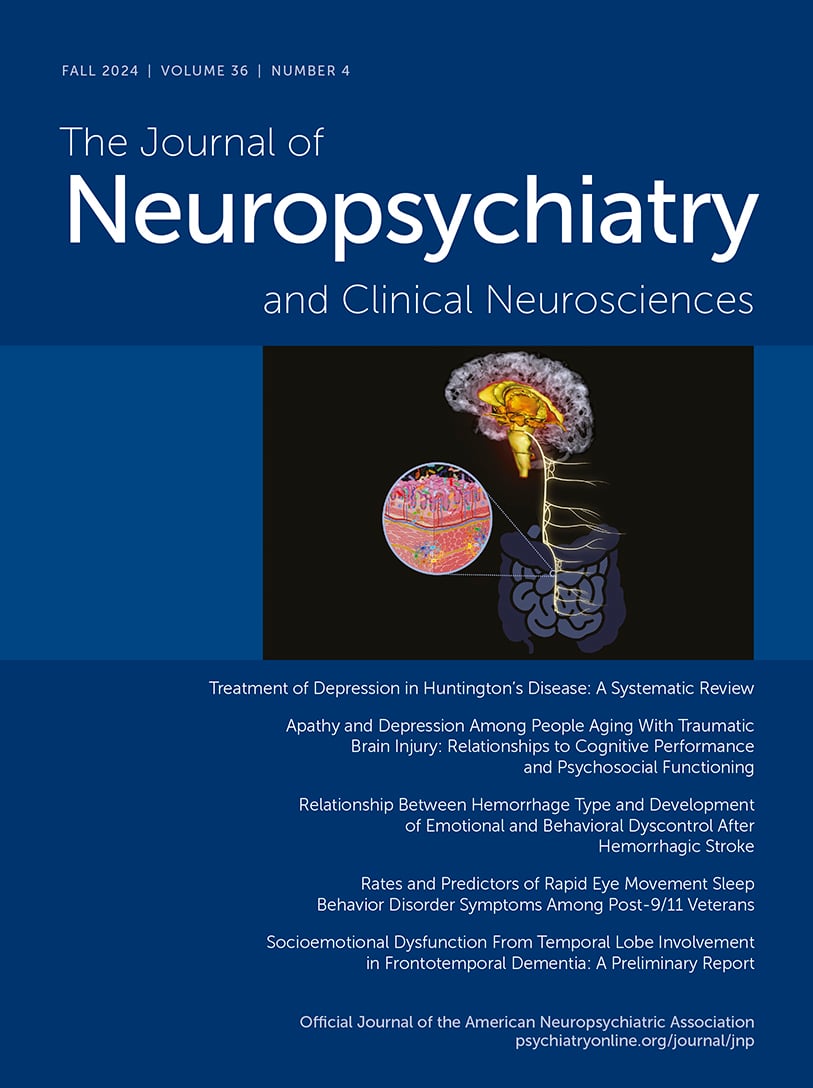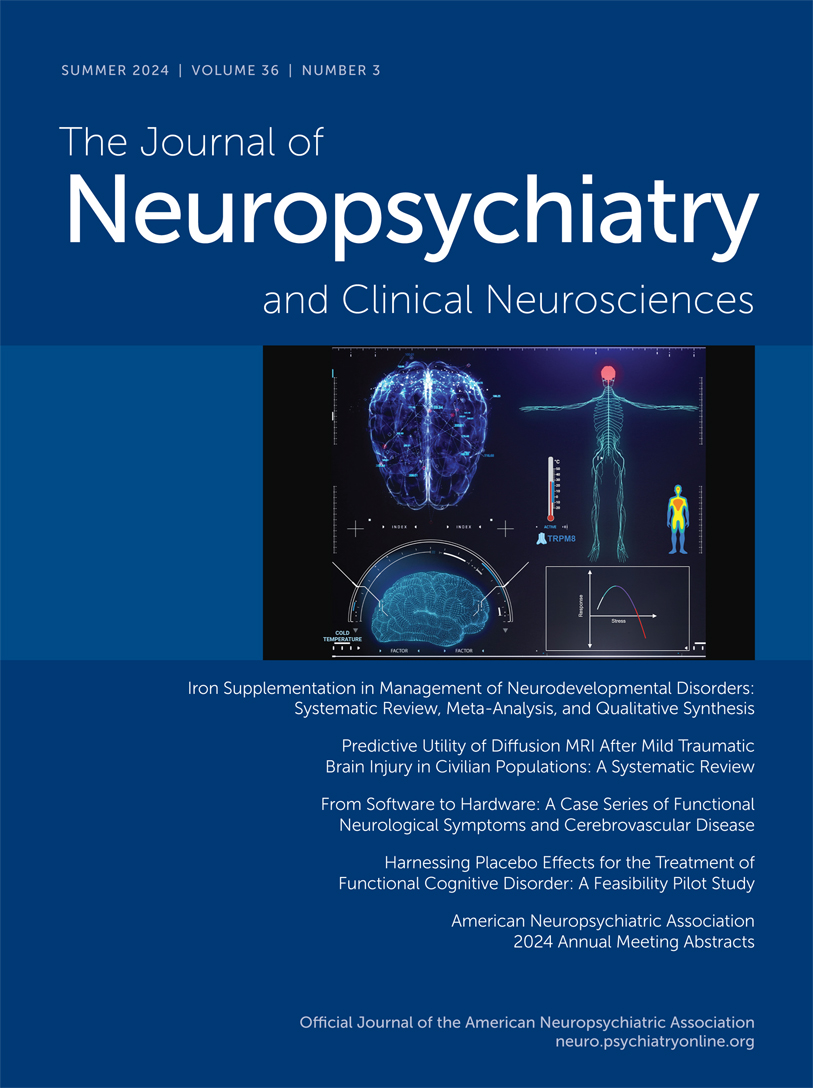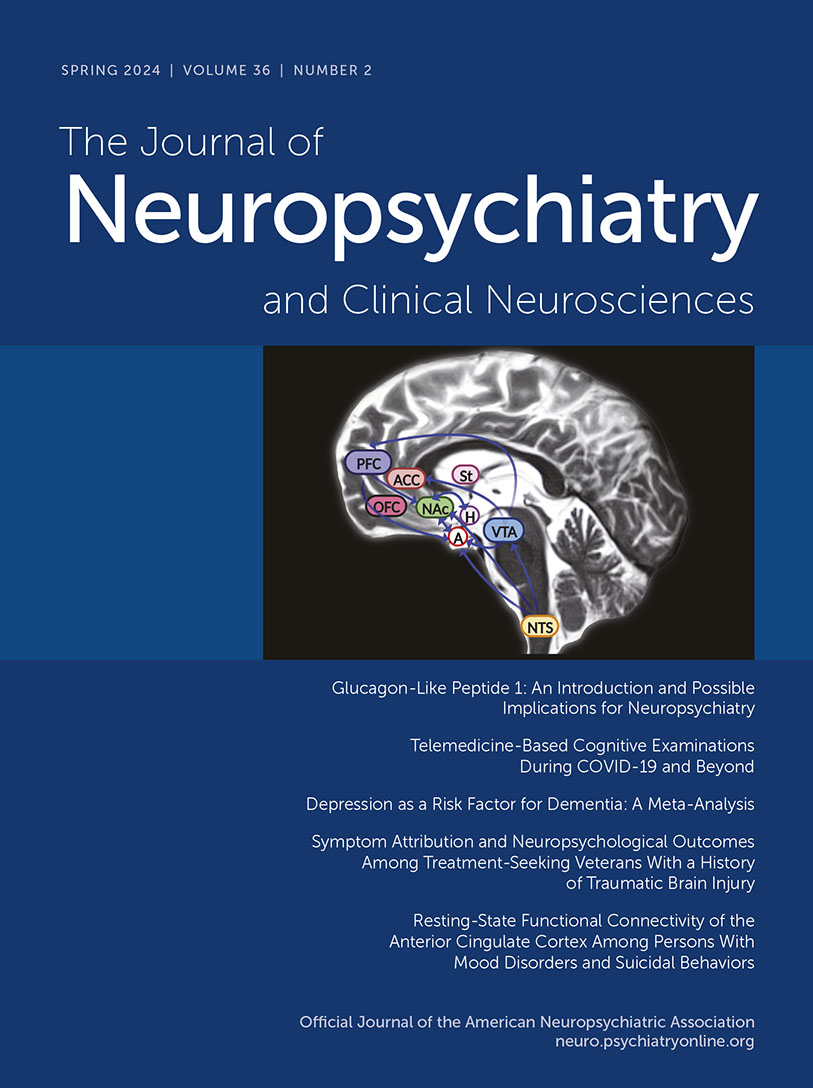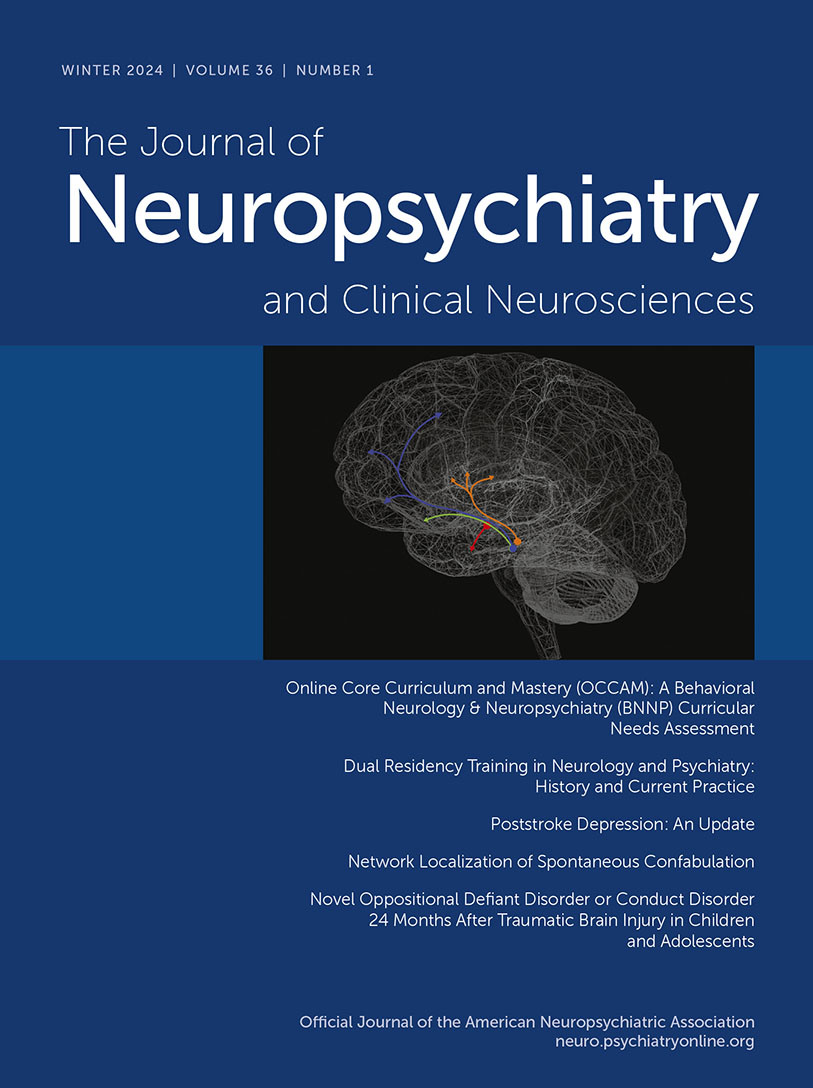The Journal of Neuropsychiatry and Clinical Neurosciences
- Volume 16
- Number 3
- August 2004
Windows to the Brain
Special Article
Publication date: 01 August 2004
Pages252–260Rheumatic fever is an immunologically mediated disease that follows infection by group A β-hemolytic Streptococcus (GABHS). In rheumatic fever, antibodies generated against GABHS cross-react with the heart, joints, skin, and other sites, inducing an ...
https://doi.org/10.1176/jnp.16.3.252Publication date: 01 August 2004
Pages261–276The behavioral and psychological symptoms of dementia (BPSD) are common serious problems that are a major contributor to caregiver burden. Despite their significance, the underlying neurobiology of these disturbances is still unclear. This review examines ...
https://doi.org/10.1176/jnp.16.3.261Regular Article
Publication date: 01 August 2004
Pages277–283Schizophrenia subjects are impaired in a number of visual attention paradigms. However, their performance on tests of figure-ground visual perception (FGP), which requires subjects to visually discriminate figures embedded in a rival background, is ...
https://doi.org/10.1176/jnp.16.3.277Publication date: 01 August 2004
Pages284–294A magnetic-resonance-imaging-based method of cortical parcellation was used to evaluate the morphology of the superior temporal plane and its subregions (Heschl's gyrus [HG], planum temporale [PT], and planum polare [PP]) in a group of 30 patients with ...
https://doi.org/10.1176/jnp.16.3.284Publication date: 01 August 2004
Pages295–305We hypothesized that specific brain regions would activate during deception, and these areas would correlate with changes in electrodermal activity (EDA). Eight men were asked to find money hidden under various objects. While functional MRI images were ...
https://doi.org/10.1176/jnp.16.3.295Publication date: 01 August 2004
Pages306–314Neuropsychological functioning in individuals with psychotic disorder following traumatic brain injury (PDFTBI), traumatic brain injury without psychosis (TBIWP), and schizophrenia were compared against each other and to the means of normal subjects. It ...
https://doi.org/10.1176/jnp.16.3.306Publication date: 01 August 2004
Pages315–319Depression in Parkinson's disease (PD) is associated with faster progression of physical symptoms, greater decline in cognitive skills, and greater decline in the ability to care for oneself. The depression in these patients is also frequently comorbid ...
https://doi.org/10.1176/jnp.16.3.315Publication date: 01 August 2004
Pages320–329We correlated measures of problem solving (Wisconsin Card Sorting Test [WCST] categories, total errors, and perseverative errors) and chronic anxiety (Personality Assessment Inventory Anxiety Scale [ANX]) in asymptomatic apolipoprotein E (APOE) e4 ...
https://doi.org/10.1176/jnp.16.3.320Publication date: 01 August 2004
Pages330–335The effect of marijuana use on cognitive function is controversial. Although marijuana use is common in HIV-infected individuals for recreational and medicinal purposes, there have been no studies of the impact of marijuana on cognitive function in these ...
https://doi.org/10.1176/jnp.16.3.330Publication date: 01 August 2004
Pages336–341Neuropsychiatry has become the subject of a number of editorials and position papers in recent years. Historical, philosophical, clinical, scientific, and educational dimensions of neuropsychiatry have been discussed in these papers. The potential ...
https://doi.org/10.1176/jnp.16.3.336Publication date: 01 August 2004
Pages342–349The pathophysiology of obsessive-compulsive disorder (OCD) is thought to involve disturbance of the frontal-subcortical circuitry. To investigate the morphological characteristics of this circuitry, we examined the volume of the orbitofrontal cortex, ...
https://doi.org/10.1176/jnp.16.3.342Publication date: 01 August 2004
Pages350–356Using the Neuropsychiatric Inventory (NPI), we studied euphoria and other behavioral changes in 75 consecutive, unselected multiple sclerosis (MS) patients and 25 healthy controls. We also assessed disease duration, clinical course, physical disability, ...
https://doi.org/10.1176/jnp.16.3.350Clinical and Research Reports
Publication date: 01 August 2004
Pages357–359[99mTc]Hexamethylpropylene amine oxime (HMPAO) single photon emission computed tomography (SPECT) brain scans were undertaken in six subjects with body dysmorphic disorder (BDD). The scans showed a broad range of discrepant findings that do not ...
https://doi.org/10.1176/jnp.16.3.357Publication date: 01 August 2004
Pages360–363In 19 patients with major depressive disorder, effective treatment with selective serotonin reuptake inhibitors (SSRIs) or amesergide (AMSG) was associated with increased cerebral perfusion in anterior cingulate cortex (SSRI and AMSG) and in medial ...
https://doi.org/10.1176/jnp.16.3.360Publication date: 01 August 2004
Pages364–366Fluvoxamine 200 mg was administered for 3 months to a group of 43 interferon β-1b treated patients affected by major depression associated with multiple sclerosis. Despite a 16.3% attrition rate, 79% of patients achieved response. The drug was well ...
https://doi.org/10.1176/jnp.16.3.364Neuropsychiatric Practice and Opinion
Publication date: 01 August 2004
Pages367–378Many diseases involve the cerebellum and produce ataxia, which is characterized by incoordination of balance, gait, extremity and eye movements, and dysarthria. Cerebellar lesions do not always manifest with ataxic motor syndromes, however. The cerebellar ...
https://doi.org/10.1176/jnp.16.3.367Book Reviews
Calendar
Letter
Correction
Past Issues
View Issues Archive
Vol. 36 | No. 4

Vol. 36 | No. 3

Vol. 36 | No. 2
